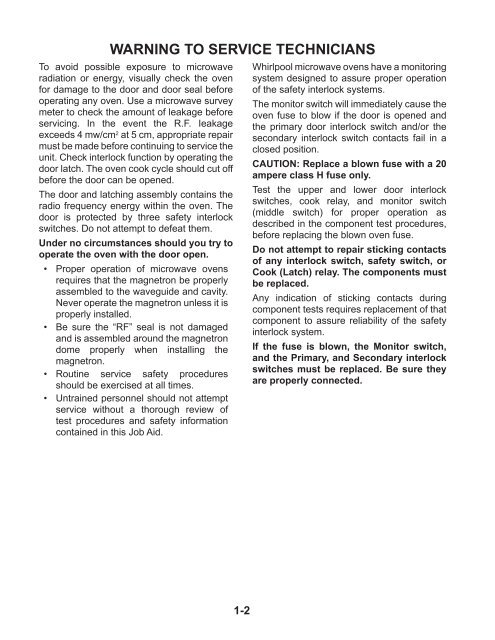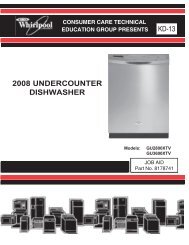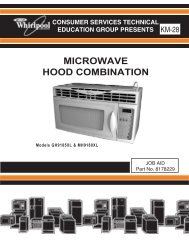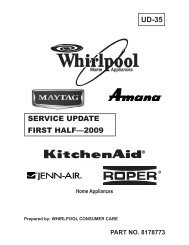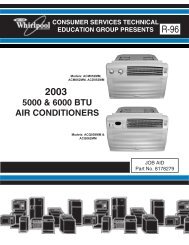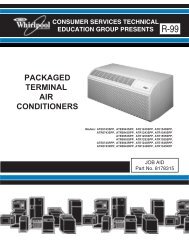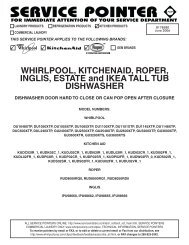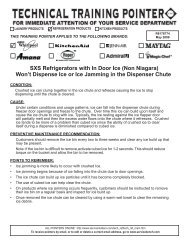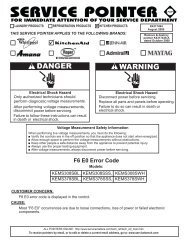removing the fc (forced convection) - This is a secure site - Whirlpool
removing the fc (forced convection) - This is a secure site - Whirlpool
removing the fc (forced convection) - This is a secure site - Whirlpool
You also want an ePaper? Increase the reach of your titles
YUMPU automatically turns print PDFs into web optimized ePapers that Google loves.
WARNING TO SERVICE TECHNICIANS<br />
To avoid possible exposure to microwave<br />
radiation or energy, v<strong>is</strong>ually check <strong>the</strong> oven<br />
for damage to <strong>the</strong> door and door seal before<br />
operating any oven. Use a microwave survey<br />
meter to check <strong>the</strong> amount of leakage before<br />
servicing. In <strong>the</strong> event <strong>the</strong> R.F. Ieakage<br />
exceeds 4 mw/cm2 at 5 cm, appropriate repair<br />
must be made before continuing to service <strong>the</strong><br />
unit. Check interlock function by operating <strong>the</strong><br />
door latch. The oven cook cycle should cut off<br />
before <strong>the</strong> door can be opened.<br />
The door and latching assembly contains <strong>the</strong><br />
radio frequency energy within <strong>the</strong> oven. The<br />
door <strong>is</strong> protected by three safety interlock<br />
switches. Do not attempt to defeat <strong>the</strong>m.<br />
Under no circumstances should you try to<br />
operate <strong>the</strong> oven with <strong>the</strong> door open.<br />
• Proper operation of microwave ovens<br />
requires that <strong>the</strong> magnetron be properly<br />
assembled to <strong>the</strong> waveguide and cavity.<br />
Never operate <strong>the</strong> magnetron unless it <strong>is</strong><br />
properly installed.<br />
• Be sure <strong>the</strong> “RF” seal <strong>is</strong> not damaged<br />
and <strong>is</strong> assembled around <strong>the</strong> magnetron<br />
dome properly when installing <strong>the</strong><br />
magnetron.<br />
• Routine service safety procedures<br />
should be exerc<strong>is</strong>ed at all times.<br />
• Untrained personnel should not attempt<br />
service without a thorough review of<br />
test procedures and safety information<br />
contained in th<strong>is</strong> Job Aid.<br />
1-2<br />
<strong>Whirlpool</strong> microwave ovens have a monitoring<br />
system designed to assure proper operation<br />
of <strong>the</strong> safety interlock systems.<br />
The monitor switch will immediately cause <strong>the</strong><br />
oven fuse to blow if <strong>the</strong> door <strong>is</strong> opened and<br />
<strong>the</strong> primary door interlock switch and/or <strong>the</strong><br />
secondary interlock switch contacts fail in a<br />
closed position.<br />
CAUTION: Replace a blown fuse with a 20<br />
ampere class H fuse only.<br />
Test <strong>the</strong> upper and lower door interlock<br />
switches, cook relay, and monitor switch<br />
(middle switch) for proper operation as<br />
described in <strong>the</strong> component test procedures,<br />
before replacing <strong>the</strong> blown oven fuse.<br />
Do not attempt to repair sticking contacts<br />
of any interlock switch, safety switch, or<br />
Cook (Latch) relay. The components must<br />
be replaced.<br />
Any indication of sticking contacts during<br />
component tests requires replacement of that<br />
component to assure reliability of <strong>the</strong> safety<br />
interlock system.<br />
If <strong>the</strong> fuse <strong>is</strong> blown, <strong>the</strong> Monitor switch,<br />
and <strong>the</strong> Primary, and Secondary interlock<br />
switches must be replaced. Be sure <strong>the</strong>y<br />
are properly connected.


